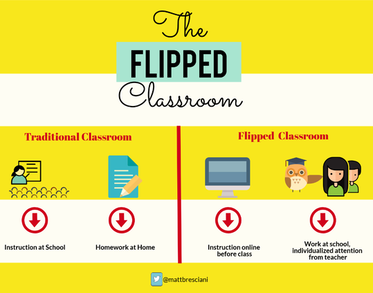Two chemistry teachers started the flipped classroom when some
their students were at home sick. The way that a flipped classroom works is,
the teacher shares a video with content that they would normally be teaching,
and the students in the class watch the video prior coming to class so that
they can be familiar with the content. While students are learning they can
rewind, pause, etc. which allows them to learn at their own pace. The teacher
serves as more of a guide with the flipped classroom model. Students can come
into class with questions about the video. Higher-level students can come in
and know exactly what to do, and lower-level students can watch the video again
and come in with questions. Teachers can
go around and lead learning activities while the students are learning. The
acronym F.L.I.P. stands for F- Flexible learning environment, L- Learning
Culture, I-intentional learning content, and P- Professional Educator. There
are eight different types of flipped classrooms: standard inverted classroom,
micro flipped classroom, discussion oriented, demonstration based, faux
flipped, group-based, virtual flipped, and role reversal. The lessons in a
flipped classroom can be presented as one lesson or a module of lessons. Some
of the benefits of the flipped classroom model are that it helps students that
are struggling, increases student-teacher interactions, works with all ability
levels, changes classroom management, educates parents and why we talk to them,
is a great tool for absent students and teachers, and is compatible with all
learning styles. A few strategies of a flipped classroom are: active learning,
peer instruction, collaboration, problem-based learning, class discussions, and
inverted classroom (regular flipped classroom). Parents love the flipped
classroom model because they can see exactly what their child is learning and
where they should be in their learning. One great thing about the flipped
classroom model is that the teacher can spend extra time with the students that
need more assistance. This is how I would use the flipped classroom model in my
future classroom. I would use it to be able to help the students that needed
extra help with particular content.


No comments:
Post a Comment